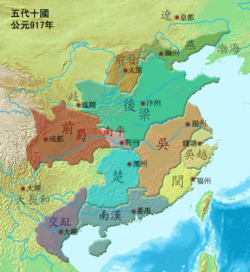Jingnan
| Nanping | ||||||||||
| 南平 | ||||||||||
|
||||||||||
|
Jingnan(南平)in 917
|
||||||||||
| Capital | Jingzhou | |||||||||
| Languages | Middle Chinese | |||||||||
| Government | Monarchy | |||||||||
| King | ||||||||||
| • | 909-928 | Gao Jixing | ||||||||
| • | 928-948 | Gao Conghui | ||||||||
| • | 948-960 | Gao Baorong | ||||||||
| • | 960-962 | Gao Baoxu | ||||||||
| • | 962-963 | Gao Jichong | ||||||||
| Historical era | Five Dynasties and Ten Kingdoms Period | |||||||||
| • | Established | 924 924 | ||||||||
| • | Ended by the Song Dynasty | 963 963 | ||||||||
|
||||||||||
Jingnan (simplified Chinese: 荆南; traditional Chinese: 荊南; pinyin: Jīngnán) (also called Nanping (南平)) was one of the Ten Kingdoms in south-central China created in 924, marking the beginning of the Five Dynasties and Ten Kingdoms period (907-960).
Gao Jichang, also known as Gao Jixing (高季興), was appointed the regional military governor of Jiangling in 907 by the Later Liang, which took over northern China in the wake of the Tang Dynasty. He declared the foundation of the Kingdom of Jingnan (or Nanping) in 924 after the Later Liang fell to the Later Tang.
Jingnan was the smallest of the longer-lived southern kingdoms. Its capital was Jiangling, and in addition to the capital, it held two neighboring districts on the Yangtze River southwest of present-day Wuhan. In addition to bordering the succession of five dynasties beginning with the Later Tang, it also shared borders with the Chu kingdom to the south, though that was replaced by the Southern Tang when it absorbed the kingdom in 951. It was also bordered by the Later Shu on the west after it was formed in 934.
Jingnan was a small and weak state, and in many ways was vulnerable to its larger, more powerful neighbors. As such, the court placed great importance in maintaining proper relations with the succession of dynasties that ruled northern China. However, because of its location, Jingnan was a central hub in trade, a feature that protected it from invasion.
...
Wikipedia

